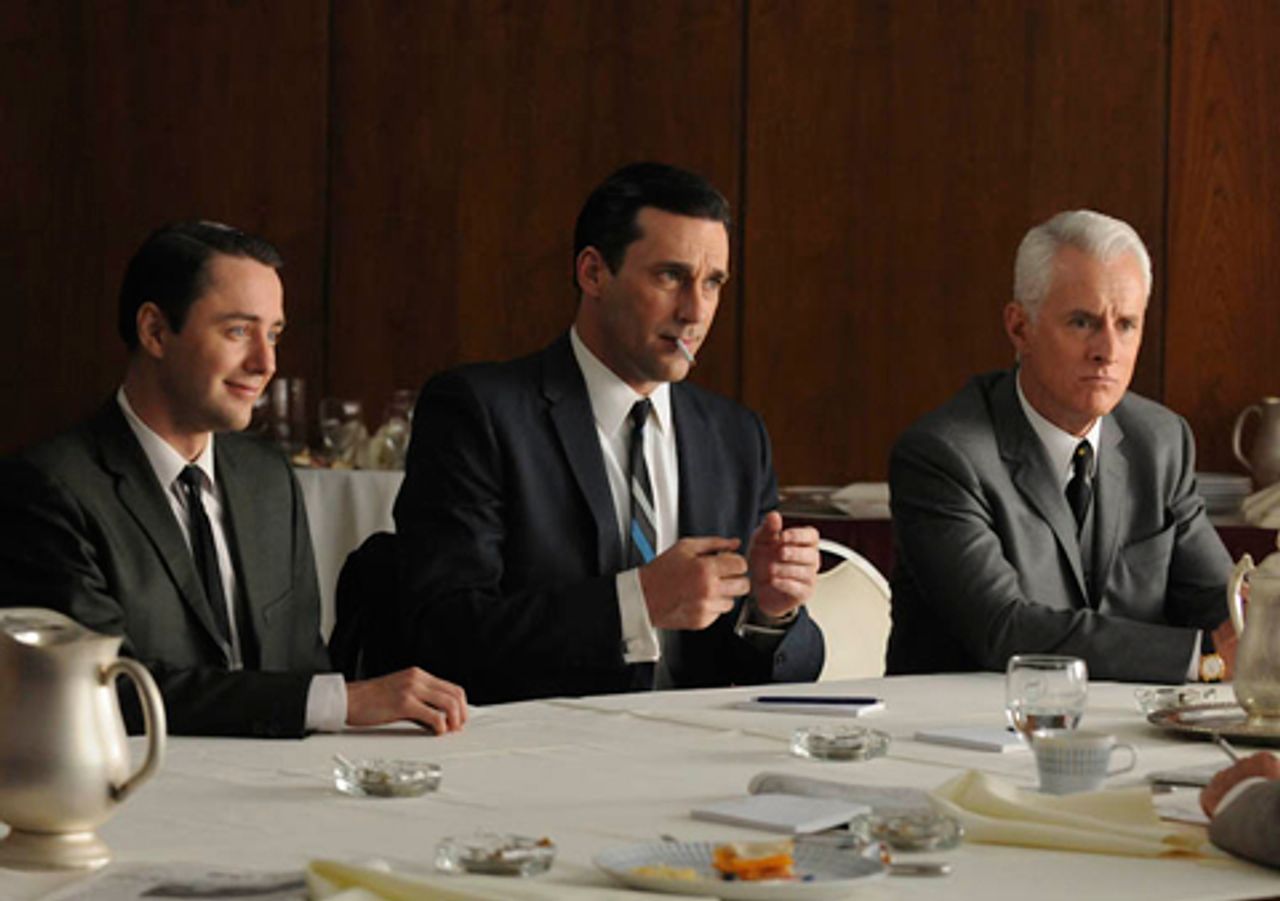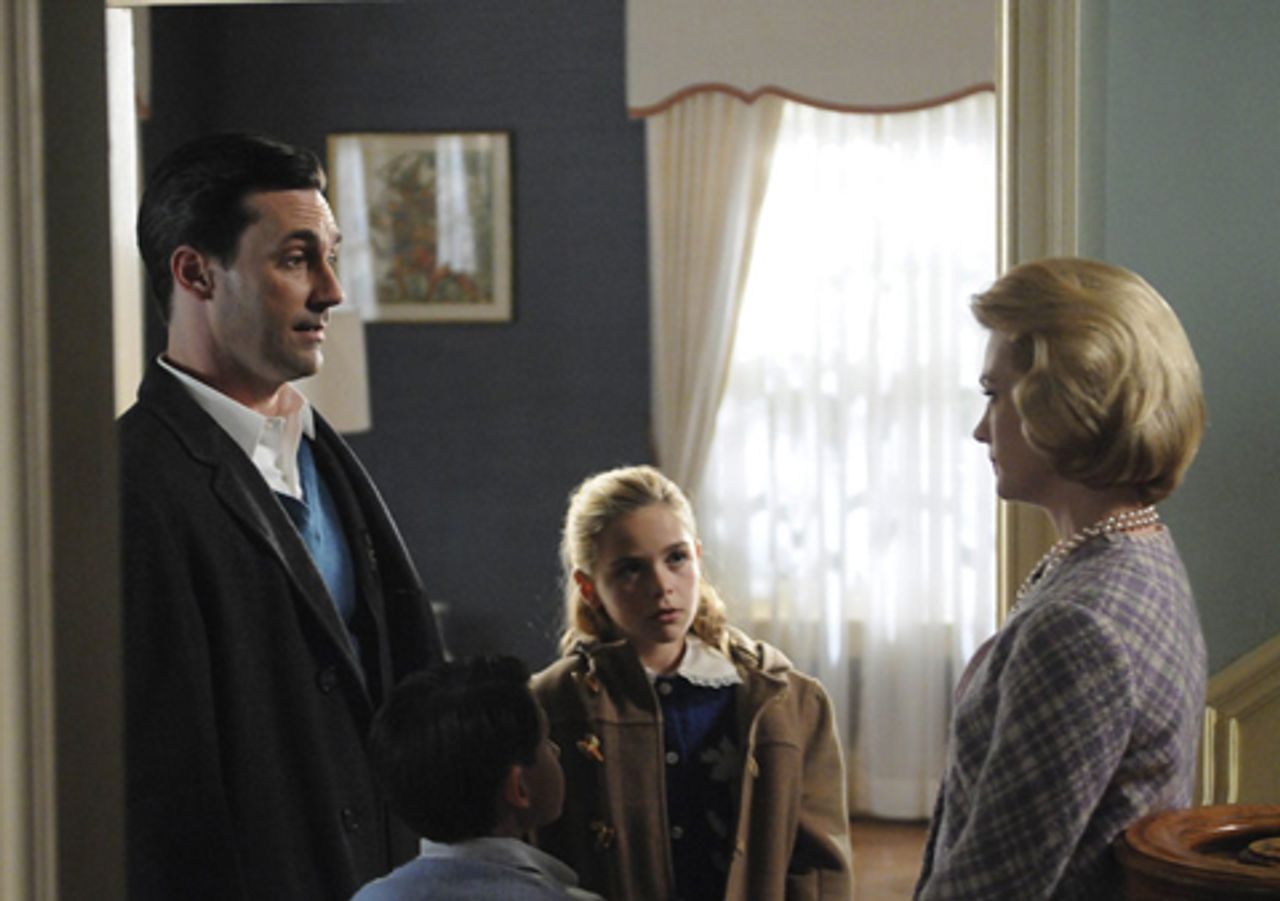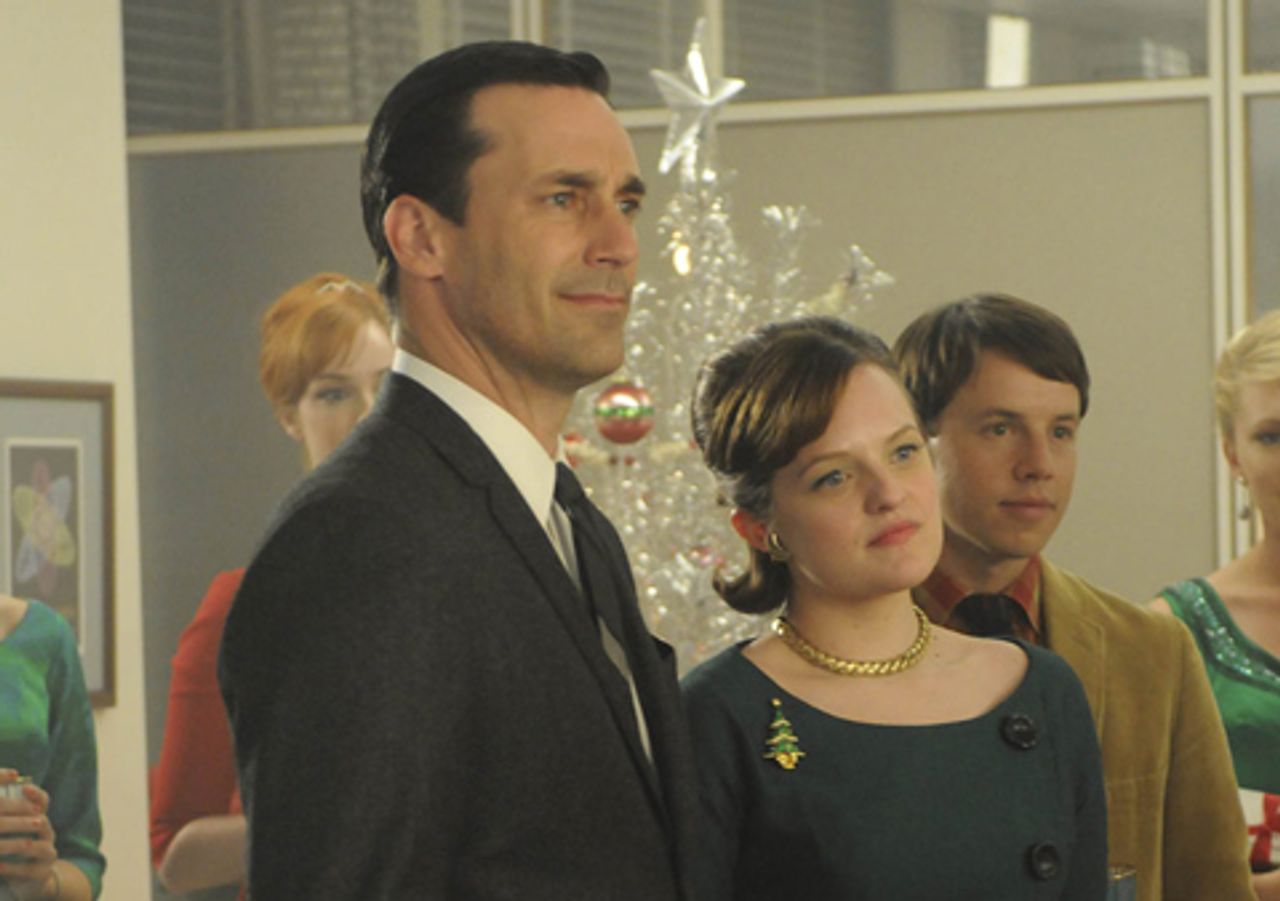AMC’s Mad Men, whose fourth season premiered Sunday night, stands out as one of the more interesting and well-written US television series at present.
 Mad Men Season 4
Mad Men Season 4The show—which focuses on a fictional advertising agency in New York City in the early 1960s—is not alone. The Wire, Hung, Treme, In Treatment, Big Love, and The Tudors, among others, suggest something of a renaissance in American television, at least by comparison to the generally banal programming of the 1980s and 1990s. A change for the better in television writing, however limited, seems both well underway and a rather stark contrast with Hollywood’s meager efforts at present.
Season three of Mad Men ended in December 1963. At that point, the ad agency at the center of the show, Sterling Cooper, was in upheaval. It had earlier been purchased by a larger British firm. Its principal owners, Roger Sterling (John Slattery) and Bert Cooper (Roger Morse), have decided to leave the acquired company in disgust. Creating a startup, Sterling and Cooper bring the show’s central character, creative director Don Draper (Jon Hamm), in as partner in the new firm.
Season four skips ahead nearly a year to November 1964 and finds the company struggling, as a much smaller organization, to bring in and retain clients and keep their doors open. A single cigarette manufacturer dominates their sales, and larger competitors are able to “throw more people” at developing sales pitches. The survival of the new firm seems to hinge on Draper. This focuses renewed and undesired attention on the protagonist.
“Who is Don Draper?” is the question that opens and closes the first episode of the new season. In the opening scene, Draper is interviewed by a reporter from Advertising Age. Draper manages to say so little about himself, ostensibly because he has grown up in the Midwest where “it’s not considered polite to talk about yourself,” that the eventual article refers to him as a handsome cipher who brings to mind no one so much as Oscar Wilde’s Dorian Gray.
To counteract the effect of that performance, which brings the firm one step closer to ruin, Draper grants another interview, this time to the Wall Street Journal, at the close of the show. Again, he is the principal subject, but now determined to “give them what they want,” he paints a grandiose self-portrait.
Those who have watched the first three seasons are well aware of Draper’s hidden and tortured history. Born Dick Whitman to the town prostitute in the rural Midwest, raised by his terrifying biological father, he was understandably eager to leave home, even if it meant ending up in the Korean War.
The war is depicted, albeit briefly, as horrific and none too noble. The death of his lieutenant soon after his arrival allows Whitman to assume the man’s identity and quickly return to the US, having seemingly escaped his past.
Moving in a rapid (and inadequately explained) manner from car salesman to creative director at a prestigious Madison Avenue agency, Draper appears the picture of success early in the first season. He has married a former model, Betty (January Jones), and has two children. The requisite home in the suburbs is appropriately decorated. Draper is soon getting around in a new Cadillac.
 Mad Men Season 4
Mad Men Season 4It proves impossible for him to keep his past entirely hidden, and the intrusion of his former life into his new situation provides a central element of the drama, particularly in Mad Men’s first two seasons. It is suggested that Don’s difficult and painful past fuels his succession of extramarital affairs and heavy drinking and smoking.
In these pursuits, Draper is hardly alone in the advertising world of the time. Not only is the three-martini lunch an institution, alcohol is liberally consumed before, during and after work by nearly all of the leading characters, its potentially destructive impact revealed in several episodes.
The critical response to Mad Men, generally very favorable, has emphasized the cultural tendencies that seem most anachronistic to modern reviewers, particularly the rampant sexism, racism and homophobia. In some of the reviews, the tone is more than a bit self-congratulatory…and false: one suspects that the prevailing attitudes in corporate boardrooms today are not so radically different from those in the early 1960s.
Rampant discrimination and harassment take their toll in the show. This is reflected in the plight of the supporting characters, especially Joan Holloway (Christina Hendricks) and Peggy OIson (Elisabeth Moss). The former is a devoted executive secretary having an affair with her boss, Sterling. She is stung as he eventually leaves his wife to wed a younger and slimmer secretary. Holloway’s own eventual marriage begins rather inauspiciously—she is sexually assaulted by her fiancé in an office at Sterling Cooper. Her chances for career advancement, notwithstanding her intelligence and capabilities, are repeatedly thwarted in the opening seasons. Wonderfully portrayed by Hendricks, Holloway is the most (and nearly the only) sympathetic character in the series.
Salvatore Romano (Bryan Batt) also finds himself cast aside in Sterling Cooper. He is gay, but (as one would expect given the period) not openly so. He is, in fact, married. His unrequited affection for a colleague oblivious to his feelings is convincing; especially poignant is the scene in which the man joins Romano and his wife at their apartment for dinner. Romano is ousted from Sterling Cooper in the third season after rejecting the advances of a client, a man in this case, who demands Romano’s firing as a condition for the firm retaining his business. Given Batt’s performance, it is to be hoped that the character returns in future episodes.
 Mad Men Season 4
Mad Men Season 4Olson is a complex character, also well acted by Moss. She is the first woman in the firm to break out from a secretarial to an executive position, overcoming considerable prejudice, taunting and a love affair that results in a child. Suffering something of a nervous breakdown following that birth, she is compelled to give up the baby. Her recuperation from that episode is among the less credible elements in the series, but, be that as it may, the new season finds her also, on the surface, the picture of success. To achieve this, however, she has been forced to adopt piecemeal many of the noxious habits and character traits of her male counterparts.
The situation confronting the homemaker is not much better. Draper’s wife Betty has by the start of season four divorced him. Her new marriage (to an aide to Nelson Rockefeller, Republican governor of New York) seems motivated by the desire for revenge as much as anything else. And the relationship is in crisis from the outset. Painful and awkward is the Thanksgiving dinner at her new mother-in-law’s house, where bitter remarks and stares greet the divorcee and her children.
Betty’s 10-year-old daughter, who was experimenting with alcohol even before her parents’ divorce, vomits up the food with which her mother tries to force-feed her, an action that strikes the viewer in both the literal and metaphoric senses. The event does not augur well for the three Draper children (a baby having arrived in the waning days of the marriage).
Draper’s character, however, is the most developed, although something of an unlikely synthesis. The frightened child and (later) young soldier has somehow been transformed into a lion of the advertising world. His insights into the mass consumer market and consumer psychology seem to come to him like music to a Mozart. Whence comes his creative genius for advertising, and how does it relate to the rest of his life? The viewer is left wondering.
Draper’s material success has come at a steep price, one indeed that is never paid off. Despite his position and wealth, Draper has never found any degree of personal happiness. Thanksgiving 1964 is a particularly dismal one for him, spent in a drab and relatively small apartment, apart from his family and accompanied by a prostitute. When he later has his children for a visit, they sit in front of the television as he works nearby. He is unable to take any delight in them.
The bitter harvest of the “American Dream” is the most interesting theme of the show, and the most promising for its future development. The critique of success as it has been defined officially in the US, has a long, if not always popular, history. Draper and Sterling bring to mind Jay Gatsby, the title character of F. Scott Fitzgerald’s 1925 novel, whose murky rise to wealth and power brings misery rather than fulfillment.
None of the characters in positions of real authority and influence in Mad Men conjure up anything like the image manufactured by Tom Brokaw (and others) of “The Greatest Generation.” Instead, the business leaders of the newly emergent “American Century” are narcissistic, avaricious and destructive. Their marriages are, as a rule, disastrous, and close personal friendships non-existent.
Real courage is in short supply as well within this layer, particularly when it comes to confronting established norms and opinions. When his real identity is about to be revealed, Draper pleads with one of his earlier lovers, the heiress and manager of a large Jewish-owned department store, Rachel Menken (acted well by Maggie Siff), to leave with him for California. She realizes the truth of the matter and confronts him with it: you don’t want to run away with me, she says, you just want to run away.
By the time of the new season, Draper’s seems out of running room. He lashes out at a prudish client, a “family company” that makes “two piece swimsuits” not (heaven forbid) “bikinis.” Sick of their apparent hypocrisy, Draper demands their representatives leave his office. From here he throws caution to the wind in his second interview. In the connected scenes, he reveals a suicidal edge. One recalls that his brother Adam took his own life after being spurned by Draper in the first season.
Hamm’s performance is particularly noteworthy and follows in something of a tradition itself. The Midwesterner or “nice” American boy with a stormy or angry interior life is one of the more interesting personas in American cinema. The dichotomy, expressed in the work of Jimmy Stewart (in Vertigo, for example) and Henry Fonda (in The Grapes of Wrath) in an earlier period, captures something essential about tendencies of character development in the US.
The new season has a decidedly more somber feel to it than the previous three. “One of the darkest episodes in the history of the show” is how David Hiltbrand of the Philadelphia Inquirer described Sunday’s opening. As one of the characters, Draper’s blind date in the show, puts it, “The world is so dark right now.” This is saying something given that the end of the previous season featured the juxtaposition of the wedding of Sterling’s daughter and the assassination of Kennedy. Particularly haunting in the new episode is the reference to the murder of civil rights workers James Chaney, Andrew Goodman, Michael Schwerner, which took place in Mississippi in June 1964.
At its best, the show has drawn attention to the darker side of postwar American reality. A significant number of Draper’s generation have come to adulthood and found themselves financially prosperous, especially by comparison to the poverty and hardship they knew in the Depression era—but at a psychic cost. The material prosperity is rooted in the hegemonic role played by the United States after the war. Coincident with its economic dominance was its becoming a bulwark against socialism and revolution in the global system.
A vast national security apparatus mushroomed. Indeed, the US became something of a “national security state,” a regime prepared to sacrifice the democratic rights of its citizens and the lives of countless numbers of people around the world to preserve the financial and political interests of its ruling elite.
The current season of Mad Men situates itself on the eve of the escalation in Vietnam where the American military would unleash mass carnage and destruction, adding to the war crimes it had committed with the use of nuclear weapons two decades earlier. Again, at the show’s best moments, something of this environment—and the way in which it found expression in emotional life and relationships—makes its way into the drama.
Mad Men appears to be growing in popularity. Nearly 3 million viewers watched Sunday’s broadcast, as opposed to less than a million for the majority of the episodes during the first season. One would like to believe this counts as evidence for interest in televised (and film) works of a more complex, realistic and demanding character.
